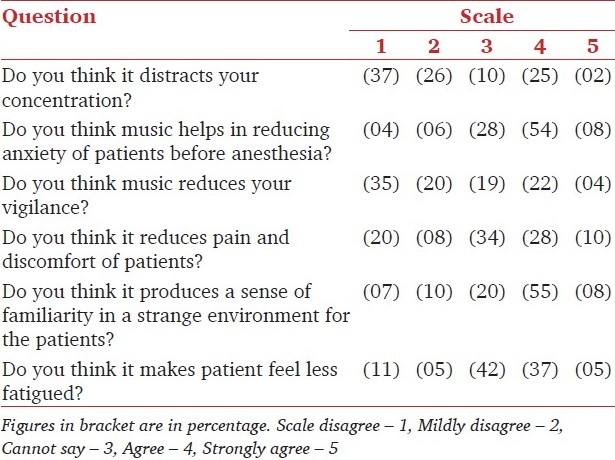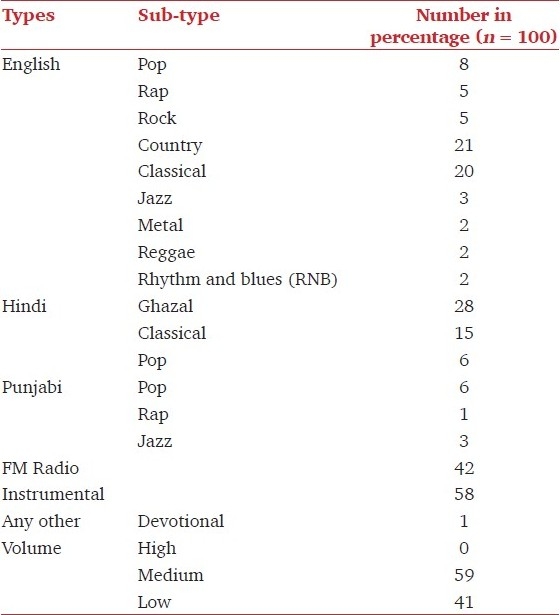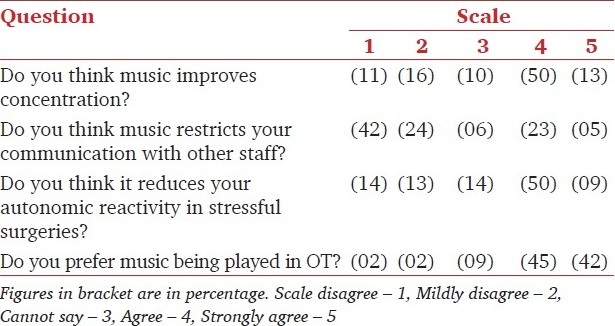Abstract
Background and Objective:
The purpose of the study was to evaluate the perception of influence of music among surgeons, anesthesiologist and nurses in our hospital as well as to critically evaluate whether music can be used as an aid in improving the work efficiency of medical personnel in the operation theatre (OT).
Materials and Methods:
A prospective, questionnaire-based cross-sectional study was conducted. A total of 100 randomly selected subjects were interviewed, which included 44 surgeons, 25 anesthesiologists and 31 nurses. Statistical package for social sciences (SPSS) Windows Version 16 software was used for statistical evaluation.
Results:
Most of the OT medical personnel were found to be aware of the beneficial effects of music, with 87% consenting to the playing of music in the OT. It was also found that most participants agreed to have heard music on a regular basis in the OT, while 17% had heard it whenever they have been to the OT.
Conclusions:
Majority of the respondent's preferred playing music in the OT which helped them relax. It improved the cognitive function of the listeners and created a sense of well being among the people and elevated mood in them. Music helped in reducing the autonomic reactivity of theatre personnel in stressful surgeries allowing them to approach their surgeries in a more thoughtful and relaxed manner. Qualitative, objective and comprehensive effect of specific music types varied with different individuals. Music can aid in improving the work efficiency of medical personnel in the OT. The study has reinforced the beneficial effects of playing music in the OT outweighing its deleterious outcomes.
Keywords: Music, medical personnel, operation theatre
Introduction
Music is a universal language transcending all barriers. It stimulates the elderly, encourages the depressed and invigorates the tired. To reap maximum benefit of music, it is important to know the extent of awareness and prevalence of its use in hospital settings. Our study was done to evaluate the general perception of influence of music in operation theatre (OT) among the surgeons, anesthesiologists and nurses in our hospital as well as critically analyse whether music could be used as an aid in improving the work efficiency in the OT.
Materials and Methods
A questionnaire-based cross-sectional prospective study was conducted. The questionnaire was answered by surgeons, anesthesiologists and nurses of our hospital. The questionnaire contained a total of 13 questions and was used to evaluate their perception of the influence of music in the OT. The study was done over a period of 2 months. The sample size was 100. This was calculated by using the formula Minimum Sample Size=4pq/d2, where ‘p’ was assumed to be 0.5. A precision of +/– 10 was allowed.
n → sample size required, p → expected, q → 1 –p, d → required precision
Taking p = 50%, d = 10%, q = 50%.
n = (4*50*50)/ (10*10) = 100
A total of 44 surgeons, 25 anesthesiologists and 31 nurses were surveyed. The questions were evaluated on a scale of 1-5 to assess the responses of the study population.
Evaluation scale: Disagree – 1; mildly disagree – 2; can’t say – 3; agree – 4; strongly agree – 5.
The data was entered on MS EXCEL OFFICE tool – Version 2007 and analysis of the same was carried out employing appropriate methods using statistical package for social sciences (SPSS) (Windows Version 16) software. Percentages were calculated for discrete variables and mean and standard deviations were used to describe continuous data. Relevant parametric and non-parametric tests were carried out to assess associations.
Results
The age, sex and participant's response data is shown as Table 1. It was found in that 17% of the study group had heard music almost whenever they had been to the OT which highlighted the fact that music was always played in our hospital OT.
Table 1.
Age, sex and response of operation theatre personnel

Effect of music on OT personnel is shown as Table 2. Among the study group 62% of the respondents thought that music helped in reducing anxiety of patients before anesthesia though 28% could not offer an opinion. Of the study population, 42% of the respondents thought that music made the patient feel less fatigued. Among the respondents 63% agreed that music produced a sense of familiarity in a strange environment for the patients, giving them emotional backup for the surgery.
Table 2.
Effect of music on operation theatre personnel and patients

The quality of music data is shown as Table 3. The preferred volume of music in the OT was also assessed, where 59% of the study population liked the music in the medium volume range. The questionnaire-based assessment also revealed that majority of the study population (58%) preferred instrumental music. The concept of music decreasing pain and discomfort in patients was consented by 38% of the respondents although 34% could not offer an opinion.
Table 3.
Type of music

The goal of the study is shown as Table 4. Of the total respondents 63% agreed that playing music improved their concentration and helped them to focus better. Speculation about music restricting the communication with other staff in OT was set aside with the results in our study, showing 66% of the respondents disagreeing with aforesaid theory and 28% agreeing to it. Our study revealed that 59% of the respondents did actually think that music helped in reducing their autonomic reactivity in stressful surgeries. It made them more calm allowing them to approach their surgeries in a more thoughtful and relaxed manner.
Table 4.
Impact of music on operation theatre personnel

Discussion
Our study revealed that 53% of the respondents listened to music on a regular basis in the hospital OT which was relatively close to that of a study done by Ulmann et al., in which 63% of the participants listened to music on a regular basis in the OT.[1]
Hawksworth et al in their study had deduced that 26 % of their study population felt music restricted their communication with other staff in the OT,[2] which was almost similar to our study finding where 28% agreed to the same. Our study revealed that 59% of the respondents thought that music helped in reducing their autonomic reactivity in stressful surgeries thus calming them down and allowing them to approach their surgeries in a more thoughtful and relaxed manner. This reaffirmed a similar finding in a study done by Allen et al.[3]
Of the total respondents 62% thought that music helped in reducing anxiety of patients before anesthesia which corroborated with the finding of a similar study by Cooke et al which had found that music significantly reduced anxiety levels.[4] The concept of music decreasing pain and discomfort in patients was consented by 38% of the respondents although 34% could not offer an opinion. According to the gate control theory which is based on the fact that pain is an integrated sensory, affective, motivational system that modulates noxious input and attenuates the perception of nociceptive inputs, it has been suggested that pain and auditory pathways inhibit each other. Perhaps the activation of auditory pathway by music during surgery inhibited the central transmission of nociceptive stimuli.[5]
Ferrer investigated the effects of familiar live music on the anxiety levels of patients and found that music brought statistically significant improvement for the experimental group on the measures of anxiety, fear, fatigue, relaxation, and diastolic blood pressure.[6] Our study showed that 63% of the total respondents agreed that music produced a sense of familiarity in a strange environment for the patient thus allaying their anxiety and fears, providing them with good emotional support to undergo surgery.
On the whole, 87% of the respondents preferred playing music in the OT which indicated that the OT staff was actually aware of the overall benefits of playing music not only from the knowledge they already possessed but also from their own personal experience.
Music has been used to achieve a wide range of outcomes not only in the hospital, but also in the community and residential care settings. It minimised anxiety levels of patients during hospitalisation and during unpleasant or invasive procedures.[6,7] It helped people relax.[8] Its effect has been measured in terms of its impact on the person's heart rate, blood pressure and respiratory rate.[9] It reduced the severity of pain and the need for analgesia in people with acute or chronic pain.[10] It was found to improve cognitive function in terms of behavior, eating and minimised the need for physical restraint for people with dementia. The effect of noisy environment produced by medical equipments in OTs and critical care units on patients was also found to be minimal, when music was played in such settings. Patients and hospital visitors were more satisfied with the care provided.[11] It improved mood and feeling of well being for a range of different patient groups.[8] It enhances tolerance level of people to unpleasant or invasive procedures, such as insertion of intravascular lines, surgical interventions, burns dressings and chemotherapy.[9,10,12]
Tempo of music around 60-80 beats per minute was found to be the best for creating relaxation. A higher tempo acted like a “driving input”, which resulted in increased heart rate, blood pressure and respiratory rate. Our study found that instrumental music was the most sought after type of music; followed by FM radio, Hindi ghazal, English country, English classical and Hindi classical in that order. However, Ulmann et al found classical music as the most preferred type of music.[1] Our study showed that OT staff preferred music with entertainment value and humor which came in generous proportions with FM radio.
The volume of the music played also had a tremendous effect on the mood of the OT staff. Of the total study population 59% of the respondents preferred medium volume while 41% preferred low volume of music in the OT. It was evident that the staff would not let music compromise or interfere with the technical aspects of patient care or competence.
Music has certain disadvantages too. It could cause distraction thus may be hazardous in the OT settings. It can restrict communication with other staff members and could be a nuisance in an emergency scenario. It could interfere with hearing patient's breathing and important alarms.[2] It could lead to unnecessary wastage of time in the form of time spent on selecting songs, adjusting volume, etc.
Hence playing music in the OT is not to be considered a trivial matter but the pros and cons of the same needed to be weighed with utmost care because it is an important determining factor in the outcome of the patient care, especially when the patient's life remains at stake on the operation table. Our study has reinforced the benefits of playing music in the OT.
Footnotes
Source of Support: Nil
Conflict of Interest: None declared.
References
- 1.Ullmann Y, Fodor L, Schwarzberg I, Carmi N, Ullmann A, Ramon Y. The sounds of music in the OR. Injury. 2008;39:592–7. doi: 10.1016/j.injury.2006.06.021. [DOI] [PubMed] [Google Scholar]
- 2.Hawksworth C, Asbury AJ, Millar K. Music in theatre: Not so harmonious.A survey of attitudes to music played in the operating theatre. Anaesthesia. 1997;52:79–83. doi: 10.1111/j.1365-2044.1997.t01-1-012-az012.x. [DOI] [PubMed] [Google Scholar]
- 3.Allen K, Blascovich J. Effects of music on cardiovascular reactivity among surgeons. JAMA. 1994;272:882–4. [PubMed] [Google Scholar]
- 4.Cooke M, Chaboyer W, Schluter P, Hiratos M. Music decreases post-operative anxiety in day surgery. J Adv Nurs. 2005;52:47–55. doi: 10.1111/j.1365-2648.2005.03563.x. [DOI] [PubMed] [Google Scholar]
- 5.Britton NF, Skevington SM. A mathematical model of the gate control theory of pain. J Theor Biol. 1989;137:91–105. doi: 10.1016/s0022-5193(89)80151-1. [DOI] [PubMed] [Google Scholar]
- 6.Ferrer AJ. The effect of live music on decreasing anxiety in patients undergoing chemotherapy treatment. J Music Ther. 2007;44:242–55. doi: 10.1093/jmt/44.3.242. [DOI] [PubMed] [Google Scholar]
- 7.Wang SM, Kulkarni L, Dolev J, Kain ZN. Music and preoperative anxiety: A randomized, controlled study. Anesth Analg. 2002;94:1489–94. doi: 10.1097/00000539-200206000-00021. [DOI] [PubMed] [Google Scholar]
- 8.Argstatter M, Haberbosch W, Bolay H. Music relaxes and calms the patient. Clin Res Cardiol. 2006;95:511–3. doi: 10.1007/s00392-006-0425-4. [DOI] [PubMed] [Google Scholar]
- 9.Leardi S, Pietroletti R, Angeloni G, Necozione S, Ranalletta G, Del Gusto B. Randomized clinical trial examining the effect of music therapy in stress response to day surgery. Br J Surg. 2007;94:943–7. doi: 10.1002/bjs.5914. [DOI] [PubMed] [Google Scholar]
- 10.Sendelbach SE, Halm MA, Doran KA, Miller EH, Gaillard P. Effects of music therapy on physiological and psychological outcomes for patients undergoing cardiac surgery. J Cardiovasc Nurs. 2006;21:194–200. doi: 10.1097/00005082-200605000-00007. [DOI] [PubMed] [Google Scholar]
- 11.Zalewsky S, Vinker S, Fiada L, Linon D. Music contributes to better doctor-patient relation. Harefuah. 1998;135:96–7. [PubMed] [Google Scholar]
- 12.Chafin S, Roy M, Gerin W, Christenfeld N. Music can facilitate blood pressure recovery from stress. Br J Health Psychol. 2004;9:393–403. doi: 10.1348/1359107041557020. [DOI] [PubMed] [Google Scholar]


